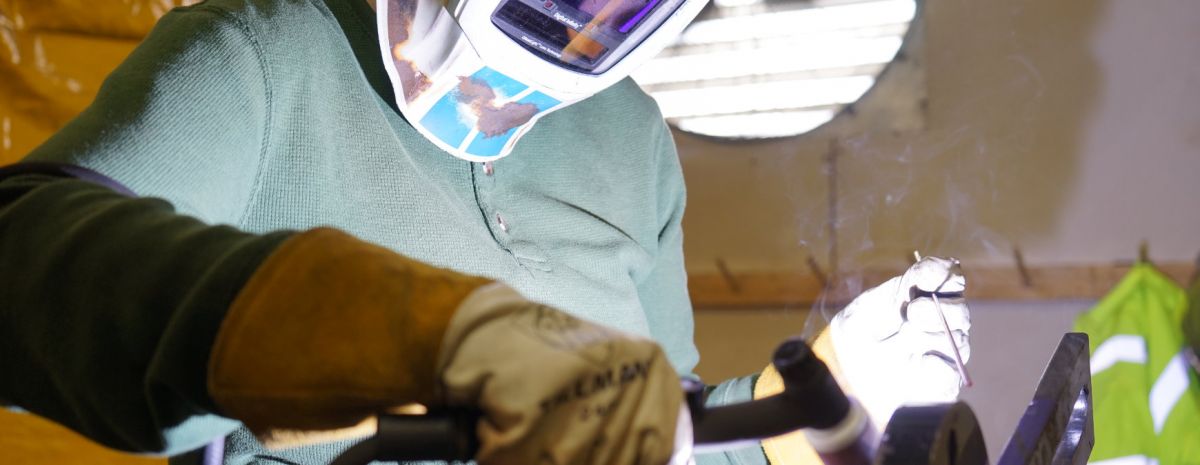TWS is a Great Training Option for Everyone
Learn more about how we can prepare you to advance your career.
Pipefitters install, maintain and repair high-pressure piping systems.1 Welding may be one of the ways that pipefitters manipulate the metal in a pipe to accomplish a job.1 How does welding fit into a pipefitting career?
What Does a Pipefitter Do?
Pipefitters, also sometimes called steamfitters, or even just fitters, are responsible for the installation, assembly, maintenance and repairs of piping fixtures and systems.1,2
The pipes involved in a pipefitter career are mostly in commercial, industrial and manufacturing settings.2 These high-pressure piping systems may include hydraulic, cooling or pneumatic systems that transport water, steam, fuel or other chemicals.3
Pipefitters may use many skills as a part of their job assembling and repairing pipes:1,3
Have You Considered a Career in the Skilled Trades?
Fill out the form to recieve a no obligation info packet.
- Cutting
- Threading
- Brazing
- Bending
- Soldering
- Grooving
- Fabricating
- Tubing
- Cementing
- Welding1,3
Pipefitters may also be involved in every part of the piping process:
- Preparing estimates
- Reading blueprints
- Following building codes
- Determining equipment that is needed
- Troubleshooting problems with piping systems2
A career in pipefitting can have many different interesting elements. Depending on your interests, pipe fitting training could be an avenue to consider. There is a lot to learn about this field, including pipefitting welding.4
What Type of Welding Do Pipefitters Do?

Pipe welding, or pipe fabrication, is when two pipes are joined together.4 Welding is one of the duties that pipefitters may perform on a job. When a pipefitter is tasked with pipe installation and assembly, they may be expected to shape the right type of metals to fit that specific industrial use. This may involve creating a sketch or blueprint of the pipe installation, selecting the size and type of pipe and creating a plan for pipe installation.1
Once a plan has been established, a pipefitter will often do the initial work to plan and prepare the pipes for welding. This may include cutting, spacing or grinding the pipes to ensure the edges are smooth and uniform.4 Then a pipefitter who is also skilled in pipe welding could possibly do that part of the job.5
A pipe welder who specializes in welding might to put down the welds after a pipefitter has cut, spaced and prepared the joints.6 It all depends on the specific job.
Types of Welds Used in Pipefitting
- Arc welding: Also called stick welding, this is the most basic type of welding. Arc welding requires an electrode and works by creating an electric arc from an alternating or direct current. There are different types of electrodes used in different types of welding. Arc welding can be used for thick, heavy metals, including cast iron.7
- MIG welding: MIG welding uses metal inert gas and is the most common and quickest form of welding. This process involves a wire feed that goes through an electrode inside a welding hand gun. This welding process can be used on mild steel, stainless steel and aluminum.7
- TIG welding: TIG welding uses tungsten inert gas and is a more expert form of welding. Instead of a wire electrode, like in MIG welding, TIG welding uses a tungsten electrode to create the arc. This type of welding can be used for metals, such as alloys.7
It is important for pipefitters and pipe welders to follow the right welding procedure for each job. For example, preparing a joint for arc welding is not the same as preparing a joint for MIG welding.4
In general, pipe welders may have some essential welding skills that help them install and repair pipes.5 Highly specialized welders, however, might be brought in to perform more complicated welds.6
Pipefitting and pipe welding may share some similarities, but they are distinct career paths. Both pipefitters and pipe welders need to create strong connections between metals and understand how metals fit together. Sometimes, a pipefitter will do some welding, and a welder will do some fitting. Or a pipefitter might decide to become specialized in pipe welding as well.6
The Role of Pipefitters in Society
Pipefitters can be essential to the healthy functioning of society because these men and women keep our piping systems working properly. These are the pipes that transport liquids and gases such as water, oil and natural gas to the areas where we live, work and play. We can thank pipefitters for installing and maintaining the pipes that give us drinking water, gas for our stoves and other essential functions.2,3
If you are interested in learning more about a pipefitting career, including the different types of welding a pipefitter may learn, contact Tulsa Welding School for more information on available training programs. Call (855) 237-7711 to speak to a representative.
1https://www.careerexplorer.com/careers/pipefitter/
2https://www.bls.gov/OOH/construction-and-extraction/plumbers-pipefitters-and-steamfitters.htm#tab-2
3https://www.careersinwelding.com/careers-in-welding/pipefitter/
4https://interestingengineering.com/common-mistakes-to-avoid-in-pipe-welding
5https://www.auto.edu/blog/five-red-hot-reasons-to-become-a-pipe-welder/
6https://www.reddit.com/r/Welding/comments/2pceq9/welding_pipefitting_explanation_plz/
7https://setxind.com/fabrication/welding-pipe-fabrication-different-processes-different-grades-piping/
This blog has been labeled as archived as it may no longer contain the most up-to-date data. For a list of all current blog posts, please visit our blog homepage at https://www.tws.edu/blog/







